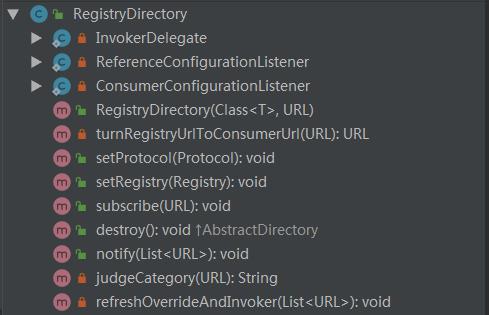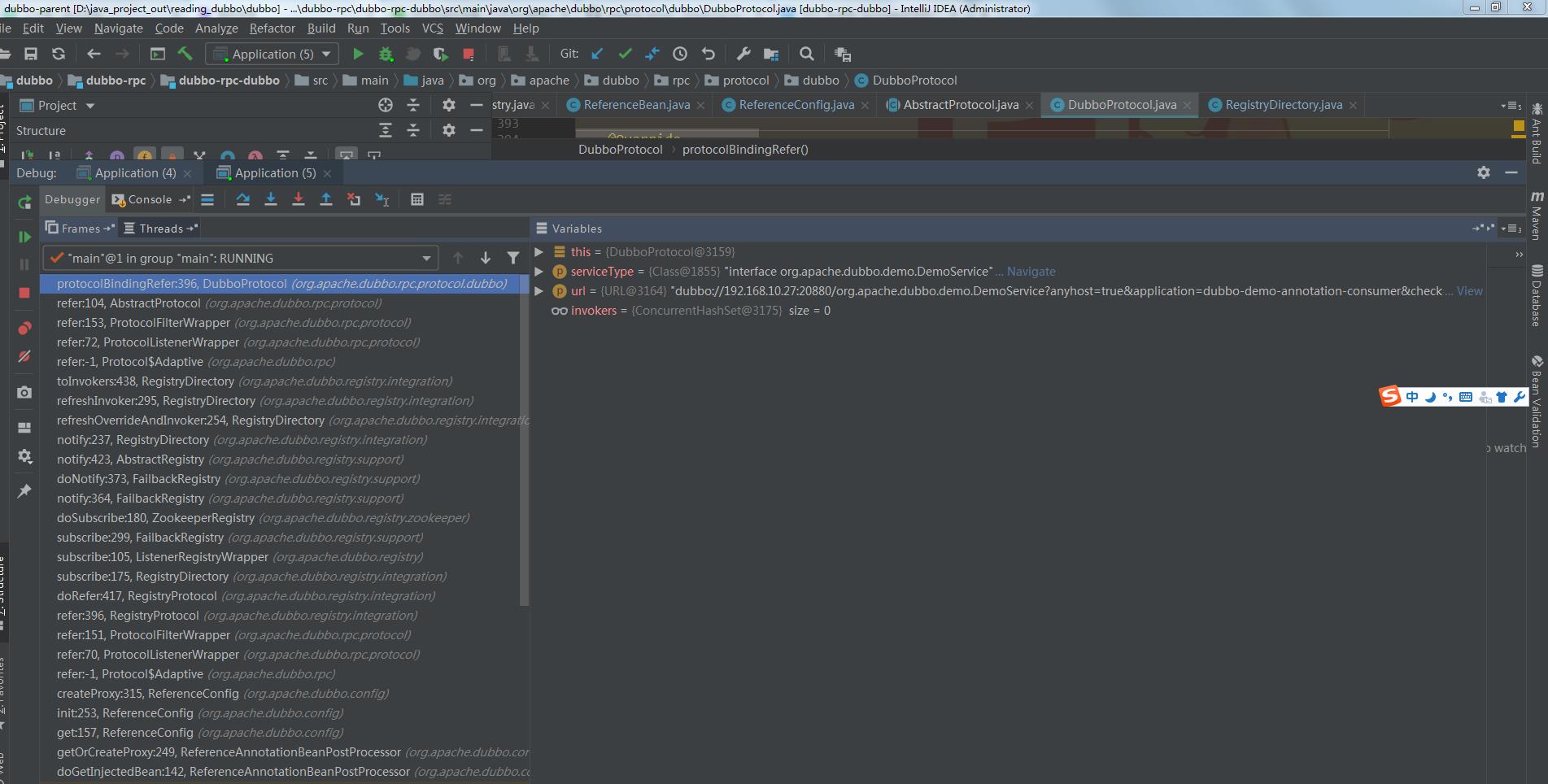dubbo学习服务字典
Posted float123
tags:
篇首语:本文由小常识网(cha138.com)小编为大家整理,主要介绍了dubbo学习服务字典相关的知识,希望对你有一定的参考价值。
文章部分描述来自官方文档,本文仅对其进行润色。
概述
我们上一节在分析服务导入的时候,createProxy 方法中,调用栈出现了 RegistryDirectory 这个类,且在这个类中进行了很多复杂的操作,最后还创建了一个 invoker ,那么这个 RegistryDirectory 到底是什么呢? 我们需要知道 invoker 是对一个 service 的某一个服务方法的抽象 。
服务目录是什么
来自官方的这两段话可以帮助我们理解
服务目录中存储了一些和服务提供者有关的信息,通过服务目录,服务消费者可获取到服务提供者的信息,比如 ip、端口、服务协议等。通过这些信息,服务消费者就可通过 Netty 等客户端进行远程调用。在一个服务集群中,服务提供者数量并不是一成不变的,如果集群中新增了一台机器,相应地在服务目录中就要新增一条服务提供者记录。或者,如果服务提供者的配置修改了,服务目录中的记录也要做相应的更新。
实际上服务目录在获取注册中心的服务配置信息后,会为每条配置信息生成一个 Invoker 对象,并把这个 Invoker 对象存储起来,这个 Invoker 才是服务目录最终持有的对象。Invoker 有什么用呢?看名字就知道了,这是一个具有远程调用功能的对象。讲到这大家应该知道了什么是服务目录了,它可以看做是 Invoker 集合,且这个集合中的元素会随注册中心的变化而进行动态调整。
源码分析
知道了服务字典的功能,我们看一下服务字典说涉及到的类
我们先看一下接口定义
public interface Directory<T> extends Node {
/**
* get service type.
*
* @return service type.
*/
Class<T> getInterface();
/**
* list invokers.
*
* @return invokers
*/
List<Invoker<T>> list(Invocation invocation) throws RpcException;
List<Invoker<T>> getAllInvokers();
}
public interface Node {
/**
* get url.
*
* @return url.
*/
URL getUrl();
/**
* is available.
*
* @return available.
*/
boolean isAvailable();
/**
* destroy.
*/
void destroy();
}
RegistryDirectory 和 StaticDirectory 都继承 AbstractDirectory ,并使用模板模式。
public abstract class AbstractDirectory<T> implements Directory<T> {
// logger
private static final Logger logger = LoggerFactory.getLogger(AbstractDirectory.class);
//某个 service 的 url
private final URL url;
private volatile boolean destroyed = false;
private volatile URL consumerUrl;
//路由相关
protected RouterChain<T> routerChain;
@Override
public List<Invoker<T>> list(Invocation invocation) throws RpcException {
if (destroyed) {
throw new RpcException("Directory already destroyed .url: " + getUrl());
}
return doList(invocation);
}
...
//交由子类实现
protected abstract List<Invoker<T>> doList(Invocation invocation) throws RpcException;
StaticDirectory
StaticDirectory 即静态服务目录,顾名思义,它内部存放的 Invoker 是不会变动的。所以,理论上它和不可变 List 的功能很相似。下面我们来看一下这个类的实现。
public class StaticDirectory<T> extends AbstractDirectory<T> {
....
@Override
protected List<Invoker<T>> doList(Invocation invocation) throws RpcException {
List<Invoker<T>> finalInvokers = invokers;
if (routerChain != null) {
try {
//调用父类的路由信息查找对应的 invoker
finalInvokers = routerChain.route(getConsumerUrl(), invocation);
} catch (Throwable t) {
logger.error("Failed to execute router: " + getUrl() + ", cause: " + t.getMessage(), t);
}
}
return finalInvokers == null ? Collections.emptyList() : finalInvokers;
}
}
RegistryDirectory
RegistryDirectory 是一种动态服务目录,实现了 NotifyListener 接口。当注册中心服务配置发生变化后,RegistryDirectory 可收到与当前服务相关的变化。收到变更通知后,RegistryDirectory 可根据配置变更信息刷新 Invoker 列表。 RegistryDirectory 中有几个比较重要的逻辑 :
- Invoker 的列举逻辑
- 接收服务配置变更的逻辑
- Invoker 列表的刷新逻辑。
后面两个逻辑可以查看上一节的方法调用栈。
@Override
public List<Invoker<T>> doList(Invocation invocation) {
if (forbidden) {
// 1. No service provider 2. Service providers are disabled
throw new RpcException(RpcException.FORBIDDEN_EXCEPTION, "No provider available from registry " +
getUrl().getAddress() + " for service " + getConsumerUrl().getServiceKey() + " on consumer " +
NetUtils.getLocalHost() + " use dubbo version " + Version.getVersion() +
", please check status of providers(disabled, not registered or in blacklist).");
}
if (multiGroup) {
return this.invokers == null ? Collections.emptyList() : this.invokers;
}
List<Invoker<T>> invokers = null;
try {
// Get invokers from cache, only runtime routers will be executed.
invokers = routerChain.route(getConsumerUrl(), invocation);
} catch (Throwable t) {
logger.error("Failed to execute router: " + getUrl() + ", cause: " + t.getMessage(), t);
}
return invokers == null ? Collections.emptyList() : invokers;
}
我们看一下 RD 的类结构,可以看到两个listener 内部类

private static class ReferenceConfigurationListener extends AbstractConfiguratorListener {
private RegistryDirectory directory;
private URL url;
ReferenceConfigurationListener(RegistryDirectory directory, URL url) {
this.directory = directory;
this.url = url;
this.initWith(DynamicConfiguration.getRuleKey(url) + CONFIGURATORS_SUFFIX);
}
@Override
protected void notifyOverrides() {
// to notify configurator/router changes
directory.refreshInvoker(Collections.emptyList());
}
}
private static class ConsumerConfigurationListener extends AbstractConfiguratorListener {
List<RegistryDirectory> listeners = new ArrayList<>();
ConsumerConfigurationListener() {
this.initWith(ApplicationModel.getApplication() + CONFIGURATORS_SUFFIX);
}
void addNotifyListener(RegistryDirectory listener) {
this.listeners.add(listener);
}
@Override
protected void notifyOverrides() {
listeners.forEach(listener -> listener.refreshInvoker(Collections.emptyList()));
}
}
可以看到更新的操作最终都是调用了 refreshInvoker 方法 。
private void refreshInvoker(List<URL> invokerUrls) {
Assert.notNull(invokerUrls, "invokerUrls should not be null");
// invokerUrls 仅有一个元素,且 url 协议头为 empty,此时表示禁用所有服务
if (invokerUrls.size() == 1
&& invokerUrls.get(0) != null
&& EMPTY_PROTOCOL.equals(invokerUrls.get(0).getProtocol())) {
this.forbidden = true; // Forbid to access
this.invokers = Collections.emptyList();
routerChain.setInvokers(this.invokers);
//删除所有的 invokers
destroyAllInvokers(); // Close all invokers
} else {
this.forbidden = false; // Allow to access
Map<String, Invoker<T>> oldUrlInvokerMap = this.urlInvokerMap; // local reference
if (invokerUrls == Collections.<URL>emptyList()) {
invokerUrls = new ArrayList<>();
}
if (invokerUrls.isEmpty() && this.cachedInvokerUrls != null) {
invokerUrls.addAll(this.cachedInvokerUrls);
} else {
this.cachedInvokerUrls = new HashSet<>();
this.cachedInvokerUrls.addAll(invokerUrls);//Cached invoker urls, convenient for comparison
}
if (invokerUrls.isEmpty()) {
return;
}
//<url,invoker>之间的映射
Map<String, Invoker<T>> newUrlInvokerMap = toInvokers(invokerUrls);// Translate url list to Invoker map
/**
* If the calculation is wrong, it is not processed.
*
* 1. The protocol configured by the client is inconsistent with the protocol of the server.
* eg: consumer protocol = dubbo, provider only has other protocol services(rest).
* 2. The registration center is not robust and pushes illegal specification data.
*
*/
if (CollectionUtils.isEmptyMap(newUrlInvokerMap)) {
logger.error(new IllegalStateException("urls to invokers error .invokerUrls.size :" + invokerUrls.size() + ", invoker.size :0. urls :" + invokerUrls
.toString()));
return;
}
List<Invoker<T>> newInvokers = Collections.unmodifiableList(new ArrayList<>(newUrlInvokerMap.values()));
// pre-route and build cache, notice that route cache should build on original Invoker list.
// toMergeMethodInvokerMap() will wrap some invokers having different groups, those wrapped invokers not should be routed.
routerChain.setInvokers(newInvokers);
this.invokers = multiGroup ? toMergeInvokerList(newInvokers) : newInvokers;
this.urlInvokerMap = newUrlInvokerMap;
try {
//删除没有使用的 invoker
destroyUnusedInvokers(oldUrlInvokerMap, newUrlInvokerMap); // Close the unused Invoker
} catch (Exception e) {
logger.warn("destroyUnusedInvokers error. ", e);
}
}
}
看完了底层更新的刷新 invoker 操作,我们看一下 notify 方法。
@Override
public synchronized void notify(List<URL> urls) {
Map<String, List<URL>> categoryUrls = urls.stream()
.filter(Objects::nonNull)
.filter(this::isValidCategory)
.filter(this::isNotCompatibleFor26x)
.collect(Collectors.groupingBy(this::judgeCategory));
List<URL> configuratorURLs = categoryUrls.getOrDefault(CONFIGURATORS_CATEGORY, Collections.emptyList());
this.configurators = Configurator.toConfigurators(configuratorURLs).orElse(this.configurators);
List<URL> routerURLs = categoryUrls.getOrDefault(ROUTERS_CATEGORY, Collections.emptyList());
toRouters(routerURLs).ifPresent(this::addRouters);
// providers
List<URL> providerURLs = categoryUrls.getOrDefault(PROVIDERS_CATEGORY, Collections.emptyList());
/**
* 3.x added for extend URL address
*/
ExtensionLoader<AddressListener> addressListenerExtensionLoader = ExtensionLoader.getExtensionLoader(AddressListener.class);
List<AddressListener> supportedListeners = addressListenerExtensionLoader.getActivateExtension(getUrl(), (String[]) null);
if (supportedListeners != null && !supportedListeners.isEmpty()) {
for (AddressListener addressListener : supportedListeners) {
providerURLs = addressListener.notify(providerURLs, getUrl(),this);
}
}
refreshOverrideAndInvoker(providerURLs);
}
private void refreshOverrideAndInvoker(List<URL> urls) {
// mock zookeeper://xxx?mock=return null
//重写 url
overrideDirectoryUrl();
//刷新invoker
refreshInvoker(urls);
}
private void overrideDirectoryUrl() {
// merge override parameters
this.overrideDirectoryUrl = directoryUrl;
List<Configurator> localConfigurators = this.configurators; // local reference
doOverrideUrl(localConfigurators);
// CONSUMER_CONFIGURATION_LISTENER 是刚才我们前面说的内部类
List<Configurator> localAppDynamicConfigurators = CONSUMER_CONFIGURATION_LISTENER.getConfigurators(); // local reference
doOverrideUrl(localAppDynamicConfigurators);
if (serviceConfigurationListener != null) {
List<Configurator> localDynamicConfigurators = serviceConfigurationListener.getConfigurators(); // local reference
doOverrideUrl(localDynamicConfigurators);
}
}
private void doOverrideUrl(List<Configurator> configurators) {
if (CollectionUtils.isNotEmpty(configurators)) {
for (Configurator configurator : configurators) {
this.overrideDirectoryUrl = configurator.configure(overrideDirectoryUrl);
}
}
}
总结
文章分析了服务目录的源码。
参考资料
- http://dubbo.apache.org/zh-cn/docs/source_code_guide/directory.html
以上是关于dubbo学习服务字典的主要内容,如果未能解决你的问题,请参考以下文章

